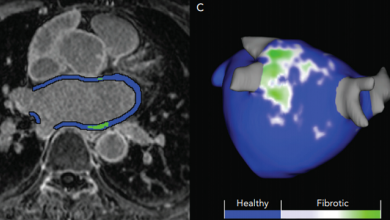Search results
Author(s):
Michael Ghannam
,
Hakan Oral
Added:
3 years ago
Maintenance of sinus rhythm in patients with non-paroxysmal AF is often challenging and complex. Catheter ablation is usually superior to anti-arrhythmic drug therapy alone. However, recurrence rates are high and have remained suboptimal. Although pulmonary vein isolation (PVI) is usually effective in treating paroxysmal AF, it is not sufficient for many patients with non-paroxysmal AF,…
View more
CMR and AF Management
Author(s):
Yan Zhao
,
Lilas Dagher
,
Chao Huang
,
et al
Added:
3 years ago
Article
Author(s):
David D Spragg
,
Irfan Khurram
,
Saman Nazarian
Added:
3 years ago
Atrial fibrillation (AF) is a remarkably common arrhythmia, affecting roughly 6 % of patients over 65 years of age, with an estimated US prevalence of over two million patients.1 That prevalence is likely to increase as patients live longer, and will contribute to rising morbidity and mortality over time.2-4
Efforts to treat AF remain imperfect. Rhythm control approaches typically consist either…
View more
Atrial Myopathy Underlying AF
Author(s):
Harold Rivner
,
Raul D Mitrani
,
Jeffrey J Goldberger
Added:
3 years ago
Article
Author(s):
Christian Mahnkopf
,
Younghoon Kwon
,
Nazem Akoum
Added:
2 years ago
Added:
6 years ago
Author(s):
Tom JR De Potter
,
Gazmend Bardhaj
,
Aniello Viggiano
,
et al
Added:
3 years ago
Percutaneous catheter treatment for atrial fibrillation (AF) has seen an exponential uptake since the first cases were published exactly two decades ago.1 Evolving over different approaches and treatment strategies, current standard of care consists of pulmonary vein isolation (PVI) through radiofrequency (RF) or other energy sources. While this treatment has been shown to be superior to…
View more
Author(s):
Sebastiaan RD Piers
,
Katja Zeppenfeld
Added:
3 years ago
Over the last 20 years ventricular tachycardia (VT) ablation has evolved from a treatment modality for selected patients withrecurrent haemodynamically tolerated VT (which can be mapped during ongoing arrhythmia), to a therapeutic option for patients with tolerated and untolerated VT using substrate-based ablation strategies.1 The substrate for VT after myocardial infarction (MI) consists of…
View more
Author(s):
Steven M Markowitz
,
George Thomas
,
Christopher F Liu
,
et al
Added:
3 years ago
Pioneering electrophysiology studies in the 1990s defined the anatomical boundaries of typical atrial flutter, identified regions for effective catheter ablation of this arrhythmia and described procedural endpoints to minimise recurrences after ablation. Activation and entrainment mapping demonstrated that typical flutter arises from reentry around the tricuspid annulus.1 Criteria to confirm…
View more
New Insights in LAAC Imaging
Author(s):
Jens Erik Nielsen Kudsk
,
,
,
et al
Start date:
Dec 06, 2022
Broadcast














